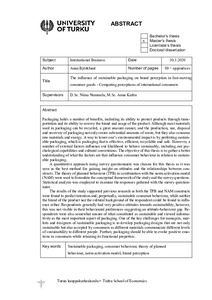The influence of sustainable packaging on brand perception in fast-moving consumer goods : Comparing perceptions of international consumers
Björklund, Anna (2020-04-06)
The influence of sustainable packaging on brand perception in fast-moving consumer goods : Comparing perceptions of international consumers
Björklund, Anna
(06.04.2020)
Julkaisu on tekijänoikeussäännösten alainen. Teosta voi lukea ja tulostaa henkilökohtaista käyttöä varten. Käyttö kaupallisiin tarkoituksiin on kielletty.
avoin
Julkaisun pysyvä osoite on:
https://urn.fi/URN:NBN:fi-fe2020041718996
https://urn.fi/URN:NBN:fi-fe2020041718996
Tiivistelmä
Packaging holds a number of benefits, including its ability to protect products through transportation
and its ability to convey the brand and usage of the product. Although most materials
used in packaging can be recycled, a great amount cannot, and the production, use, disposal
and recovery of packaging not only create substantial amounts of waste, but they also consume
raw materials and energy. A way to lower one’s environmental impact is by preferring sustainable
packaging, which is packaging that is effective, efficient, recyclable and safe. However, a
number of external factors influence our likelihood to behave sustainably, including our psychological
capabilities and cultural conventions. The objective of this thesis is to gather a better
understanding of what the factors are that influence consumer behaviour in relation to sustainable
packaging.
A quantitative approach using survey questionnaire was chosen for this thesis as it was
seen as the best method for gaining insight on attitudes and the relationships between constructs.
The theory of planned behaviour (TPB) in combination with the norm activation model
(NAM) were used to formulate the conceptual framework of the study and the survey questions.
Statistical analysis was employed to examine the responses gathered with the survey questionnaire.
The results of the study supported previous research as both the TPB and NAM constructs
were found to predict intention and, perpetually, sustainable consumer behaviour, while neither
the brand of the product nor the cultural background of the respondent could be found to influence
either. Respondents generally had very positive attitudes towards sustainability, however,
this was not visible in their behavioural preferences suggesting an attitude-behaviour gap. Respondents
were also somewhat unsure of what constituted as sustainable and viewed informativity
as the most important aspect of packaging. One of the key challenges for managers, markets
and designers of sustainable packaging is to develop packaging designs that are not only
sustainable but also accepted by consumers as different materials communicate different levels
of sustainability to different people. Further, packaging should be able to evoke positive emotions
in consumers while retaining its functional properties.
and its ability to convey the brand and usage of the product. Although most materials
used in packaging can be recycled, a great amount cannot, and the production, use, disposal
and recovery of packaging not only create substantial amounts of waste, but they also consume
raw materials and energy. A way to lower one’s environmental impact is by preferring sustainable
packaging, which is packaging that is effective, efficient, recyclable and safe. However, a
number of external factors influence our likelihood to behave sustainably, including our psychological
capabilities and cultural conventions. The objective of this thesis is to gather a better
understanding of what the factors are that influence consumer behaviour in relation to sustainable
packaging.
A quantitative approach using survey questionnaire was chosen for this thesis as it was
seen as the best method for gaining insight on attitudes and the relationships between constructs.
The theory of planned behaviour (TPB) in combination with the norm activation model
(NAM) were used to formulate the conceptual framework of the study and the survey questions.
Statistical analysis was employed to examine the responses gathered with the survey questionnaire.
The results of the study supported previous research as both the TPB and NAM constructs
were found to predict intention and, perpetually, sustainable consumer behaviour, while neither
the brand of the product nor the cultural background of the respondent could be found to influence
either. Respondents generally had very positive attitudes towards sustainability, however,
this was not visible in their behavioural preferences suggesting an attitude-behaviour gap. Respondents
were also somewhat unsure of what constituted as sustainable and viewed informativity
as the most important aspect of packaging. One of the key challenges for managers, markets
and designers of sustainable packaging is to develop packaging designs that are not only
sustainable but also accepted by consumers as different materials communicate different levels
of sustainability to different people. Further, packaging should be able to evoke positive emotions
in consumers while retaining its functional properties.
